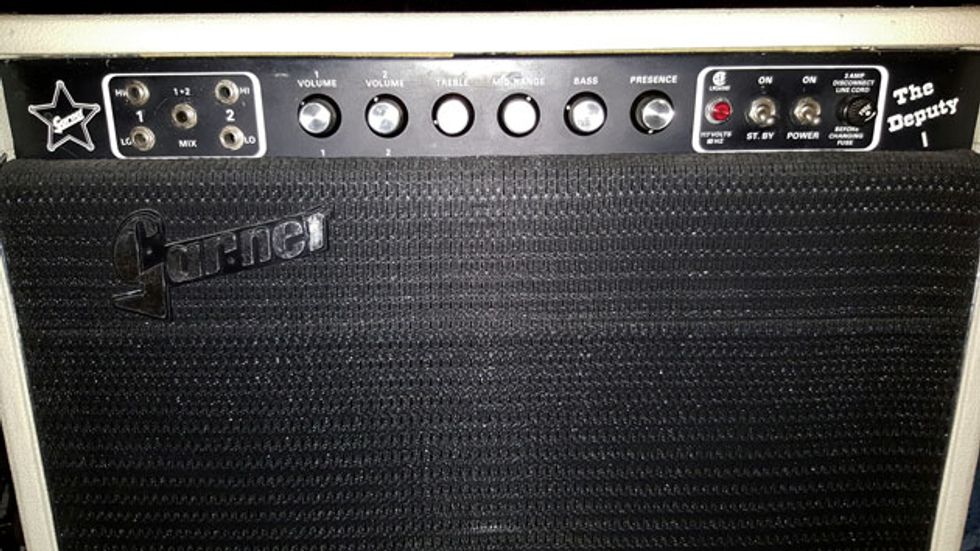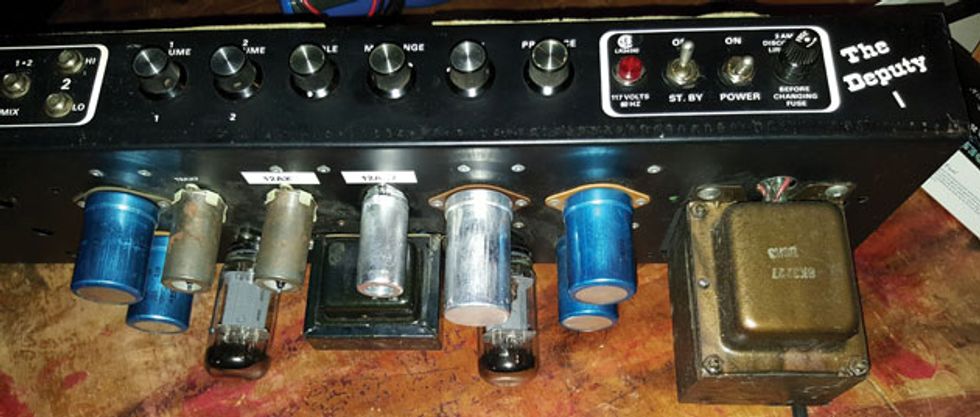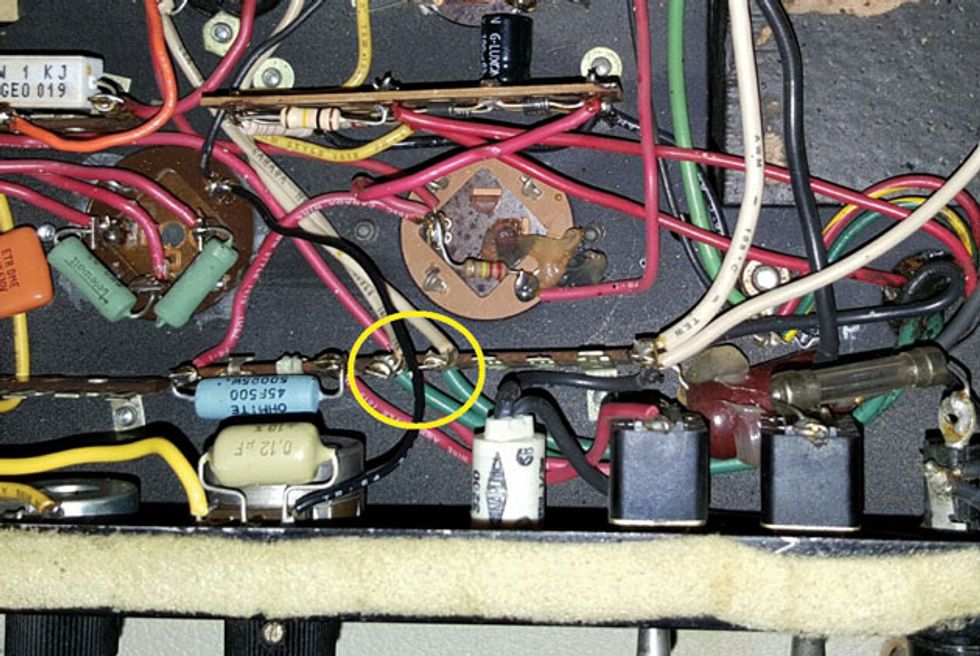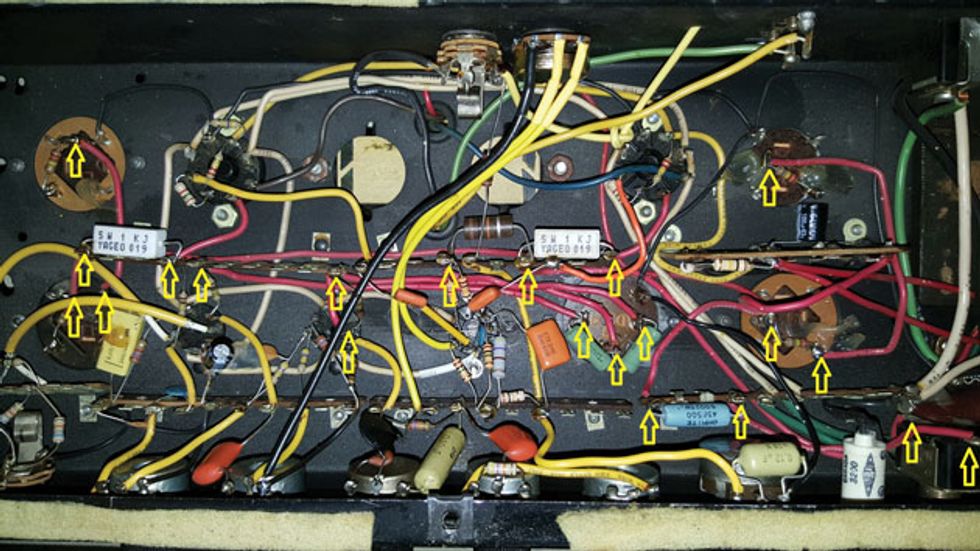Intermittent problems can be caused by a variety of sources, from failed tube sockets to an arcing switch.
Photo 1 — Canada-based Garnet ceased production in 1989. Their amps—like this 1977 Deputy combo—were used most famously by Winnipeg homies the Guess Who.
Hey Amp Man,
I’ve got a cool ’77 Garnet Deputy that stopped working properly about a year ago. The jewel light goes on when I flip the power and the tubes start to glow, but no sound comes out when I flip it out of standby. However, if I sit there long enough strumming the guitar, the amp will suddenly kick in. Sometimes it takes five minutes; sometimes it takes an hour for the amp to start working, but it always seems to cut back out again in just a few minutes. How do I go about troubleshooting this problem?
Thanks for any help!
Brian
Hi Brian,
Thanks for your question. As avid listeners to our Amps & Axes podcast know, my first “new” amp as a kid was a Garnet, so when I saw this question, I knew I needed to answer it for this column. Mine was a head with a 2x12 extension cabinet, but it was black and, of course, not as cool as your white Deputy combo. But enough about me. Let’s see if I can help you find what’s ailin’ your Deputy.
Let’s look at a couple statements you made and try to come up with some conclusions. You mention that the pilot light comes on, which, according to the schematic, is on the primary side of the mains transformer, so that tells us that the mains switch and fuses are good. You also mention that the tubes glow, so that tells us that the filament windings on the secondary side of the transformer are working. Good. The final fact you have given me is that the amplifier will eventually start working.
This chassis view reveals a classic-looking tube array, with plenty of sockets that could be a cause of the
amp’s intermittent operation.
This is what’s known as an intermittent condition and, while problematic, the fact that the amp will work at all tells me that the high-voltage windings of the mains transformer are working and that the output transformer is functioning as well. Since transformers rarely exhibit an intermittent condition, I have to assume (for the sake of this column) they are both fine. So what’s causing the problem? Let’s walk through the next logical set of troubleshooting steps.
The first thing I would suspect in most tube amps with symptoms such as these is the rectifier tube and/or socket. Since this particular amp uses diodes and not a tube to develop the DC high voltage, we can rule this out. Next, I would suspect a filament voltage issue. You mentioned that you can see the tubes glow, but are you sure all the tubes are glowing? It’s often easy to see the output tubes glow, but sometimes not so easy to see this in some preamp tubes, due to their location. Give a good look to see if they are all lit. If one does not appear to be lit, instead of wiggling the tube to see if it lights, which would probably be the propensity of most, try to be patient and wait until the amp is functioning and then take a look at the tube again.
WARNING:
All tube amplifiers contain lethal voltages. The most dangerous voltages are stored in electrolytic capacitors, even after the amp has been unplugged from the wall. Before you touch anything inside the amp chassis, it’s imperative that these capacitors are discharged. If you are unsure of this procedure, consult your local amp tech.If it appears to be glowing now, we know the problem is being caused by an intermittent filament condition on that tube. You can try replacing the tube, but tube filaments are rarely intermittent, so I would suspect the socket or its wire connections. You can first try cleaning the socket (in fact, I’d clean all the sockets) with some electronic contact cleaner without lubricant and see if that alleviates the problem. If not, we need to have a look inside the chassis. There are lethal voltages in tube amps, so be sure all the high-voltage caps have been discharged! If you’re not familiar with this procedure, you should refer this repair to your local, experienced tube amp service tech.
Fig. 1 — Follow the green wires coming from the mains transformer to begin a thorough check of all the filament connections on all the tubes.
Assuming you noticed a problem with the filament being intermittent, check the filament connections on all the tubes. There will be a pair of green wires coming from the mains transformer. These are the 6.3V filament leads. You can follow them to a terminal strip (Fig 1). From there, a pair of white wires travels to the first output tube, then the second, and then on to the three preamp tubes. Check all these filament connections (pins 2 and 7 on the output tubes, and pins 4, 5, and 9 on the preamp tubes) and make sure all are good. And remember, if you see a tube with its filament not lit, the problem could not only be on that socket, but the socket electrically before it as well. There’s certainly nothing wrong with re-soldering all these connections, just to be sure.
Fig. 2 — Since this amplifier is a great example of what the term “point-to-point wired” actually means, it’s not too difficult to follow the layout.
If that didn’t cure the problem, there is one more set of connections we can check that may be responsible for an intermittent condition such as this: the HT or high-voltage connections. Since this amplifier is a great example of what the term “point-to-point wired” actually means, it’s not too difficult to follow the wiring, which makes this procedure very easy to explain. Simply check the connections of every red wire in the amp (Fig 2). This is how all the high voltage is distributed, so, again, be sure all the high-voltage caps have been discharged! I would also recommend checking the standby switch. Make sure it has a relatively firm click when switched. Sometimes these switches arc internally due to the high voltage and they can wear out over time.
Hopefully one of these procedures has cured your amp. If not, it’s time for a trip to your local service tech for further examination. Fun fact about these amps: There is conjecture that the name Deputy is a nod to the fact that this amp was a knockoff of a British amp called Marshall. Examination of the schematic reveals the input stages of the two channels are, indeed, early Marshall-esque, as is the cathode-follower tone circuit, but the values in the tone stack are indeed American. Of course, they are! How else could Garnet user Randy Bachman have recorded “American Woman?” Until next time!





